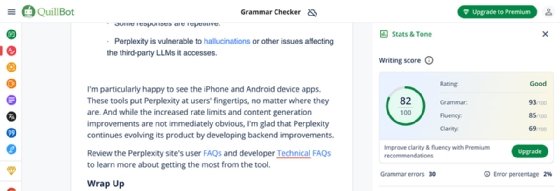
Getty Images
Hands-on with QuillBot AI: Review and guide
Learn how one professional author uses QuillBot AI for writing tasks -- and how it stacks up to other popular options like Grammarly.
In my experience, AI tends to affect writers in two ways.
In one sense, AI can be perceived as a threat, with some executives suggesting that AI can easily replace writers. In another sense, AI can be a tool that strengthens a writer's fundamental ability to communicate.
Writers strive for accuracy, clarity and originality, so any tool that helps users improve in these areas is beneficial. As generative AI is increasingly used across industries, AI writing tools have become a popular addition to the writer's toolkit.
One such tool, QuillBot AI, helps writers create content for their readers, from documentation and blog posts to textbook analyses and emails. QuillBot includes a variety of core features, subscriptions and use cases.
But it's just one of many AI writing tools on the market. Keep reading for a review of QuillBot compared to Grammarly and my assessment of the tool's usefulness to me as a professional author.
QuillBot AI's core features
QuillBot AI includes standard editorial features designed to aid students and researchers, such as a grammar checker, plagiarism checker and citation generator. It can also help with the more creative aspects of writing by offering paraphrases, writing prompts and other suggestions.
QuillBot's core features include the following:
- Grammar checking. Includes spelling, mechanics, punctuation and spacing.
- Plagiarism checking. Not included with the free version.
- Summarization. Offers paragraph and bullet point modes and summary length variations.
- Paraphrasing. Includes rewriting in various tones.
- Translation. Languages include Spanish, French and more.
- Citation generation. Based on titles, URLs, ISBNs and other indicators.
- Flow. QuillBot's native word processor. It includes AI integration and provides web search results, grammar checking, content analytics, prompts and more.

QuillBot also offers an AI detector that attempts to determine what percentage of a document was written using AI. The tool displays a confidence level, indicating the level of certainty that the content originates from AI. The free version's AI detector has a 1,200-word limit.
Note that while AI detector tools can come in handy as a starting point for detecting AI-generated content, detectors today are not foolproof. Human investigation is needed to conclusively determine whether something was written by AI.
QuillBot AI pricing and integration
QuillBot AI offers three subscription plans.
The Free Plan includes the following:
- No cost, no credit card registration and no user account required.
- Paraphrases up to 125 words in two modes.
- Identifies basic grammatical and spelling errors.
- Generates basic summaries.
- AI detector for up to 1,200 words.
The Premium Plan is an annual rate of $8.33 per month and adds these features:
- Unlimited paraphrasing in all modes.
- Advanced grammar checking.
- Custom summaries.
- AI detector for an unlimited number of words.
- Plagiarism checking.
- Translation into more than 40 languages.
- Synonym adjusting.
The Team Plan offers pricing based on seats and includes everything in the Premium Plan, plus these features:
- Team usage metrics.
- Data control and management dashboards
- Centralized billing and personal support.
QuillBot AI is available as a Chrome browser extension -- handy for those using web-based tools like Drupal or WordPress -- or a Microsoft Word plugin. You can also add QuillBot to Apple Safari, Microsoft Edge or a macOS device.
Comparing QuillBot AI to other tools
General-use AI chatbot tools such as Anthropic's Claude or OpenAI's ChatGPT don't compare well to QuillBot because they are intended for a broader scope of uses. While tools like ChatGPT can provide a certain amount of editing capability, it's not their primary function. Writing-specific AI tools like QuillBot, in contrast, are much narrower in scope.
Here are additional AI writing tools to consider that are closely related to QuillBot:
- Jasper AI. For marketing and creative content generation.
- Hemingway. For tone and readability improvement.
- Turnitin. For plagiarism checking.
- Grammarly. For grammar checking, tone improvement and style.
QuillBot AI vs. Grammarly: Hands-on evaluation
I tested QuillBot AI using a draft copy of another article I wrote for Informa TechTarget's Search Enterprise AI. The Word document is 1,853 words. After inputting the draft, the free version of Grammarly processed it almost immediately, with 38 spelling and grammatical suggestions for me to review. QuillBot took longer -- nearly 10 seconds -- and offered 30 suggestions.
The QuillBot interface is straightforward and logical. It's easy to understand what it's suggesting and quick to implement changes. Grammarly's free version was just as simple.
When using the Premium plan, selecting the View details button in the QuillBot interface displays writing statistics, readability level and tone.

QuillBot also offered AI commands along with its suggestions, enabling me to expand on a concept or rephrase the text for increased readability.

Having worked with these kinds of grammar-checking tools before, I will say that an experienced author should continue to trust their own knowledge. I've found many places where checkers offer incorrect or illogical suggestions. I've also seen situations where the suggestions don't fit the overall tone. Remember, the content is yours, not the AI tool's, so retain control; I never select the Accept all option.
I did get frustrated with QuillBot AI's free version, but let's face it -- they want you to subscribe to the paid tier. I was surprised at how much slower the initial analysis felt compared to Grammarly. It's not enough to cause an issue, but it was noticeable.
Testing unconventional use cases
While QuillBot works well with standard writing tasks, I wanted to challenge it with some less conventional content.
I tried dropping some Markdown pages into QuillBot AI to see what it would do with the odd formatting instructions -- and overall, it did well. It didn't call out the various odd brackets, hashtags and other characters. It did bold text per the Markdown instructions, whereas things it couldn't parse were left alone. Overall, I wouldn't use QuillBot to analyze my Markdown projects, but it was a worthwhile exercise and I feel confident the tool would catch basic errors.
Next, I put the Python code for a number-guessing game in the grammar checker. It dropped all indentations but did not call out special characters or odd formatting. Again, it is not designed for actual code, and I would not use it to find syntax errors. However, it handled the code surprisingly well.
QuillBot AI: Is it worth it?
AI writing tools are here to stay, and while I was initially skeptical, I've come to use various AI tools for research and grammar checking. I don't feel that generative AI can match a real author, but handy components like translation and summarization make AI writing tools useful for authors.
The free version of QuillBot is complete enough to enable writers to determine if the Premium Plan would be cost-effective.
QuillBot is a definite contender in this space, going head to head with more established tools like Grammarly.
Damon Garn owns Cogspinner Coaction and provides freelance IT writing and editing services. He has written multiple CompTIA study guides, including the Linux+, Cloud Essentials+ and Server+ guides, and contributes extensively to Informa TechTarget, The New Stack and CompTIA Blogs.







